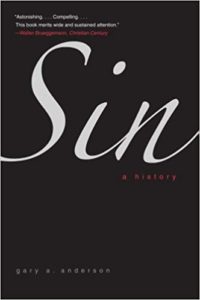
Sin: A History
Gary A. Anderson, professor of Old Testament/Hebrew Bible in the Department ofTheology at Notre Dame, argues that sin has a history. He uncovers this history in the shifting metaphors for sin found in the Bible, Aramaic texts of the Second Temple period, early rabbinic Judaism, and the Church Fathers. Sin, as a concept, has evolved. The evolution, says Anderson, is primarily linguistic and can be traced through commercial and economic images from the end of the Hebrew Bible period to the late medieval idea of a “treasury in heaven.”
Using language theory developed by George Lakoff, Mark Johnson, and Paul Riccoeur as a starting point, Anderson argues that biblical expressions of both sin and forgiveness are first and foremost cultural idioms that can be understood only through metaphor. These metaphors are fluid, and they change according to the milieu of specific texts. Prior to the Babylonian exile in 587 B.C., the Bible describes sin predominantly as a burden to be borne. Leviticus 16:22, for example, explains how on the Day of Atonement, Israel’s severe sins are to be removed annually through ceremony of the scapegoat symbolically carrying transgressions into the desert. Likewise the metaphor of sin as burden is found in the Genesis story of Cain and Able as well as the prophetic books of Isaiah and Ezekiel. The metaphor changes, however, after the Babylonian exile when Persia emerged as the dominant political power in the Ancient Near East. With the Persian Empire came the Aramaic language, and with the Aramaic language the metaphor of sin as burden was replaced with the commercial metaphor of sin as a debt that demanded repayment.
The idea of sin as debt suffused the Jewish world of the Second Temple period. Anderson explores this metaphor through careful exegeses of rabbinical interpretations of Leviticus 25-26, Isaiah 40-66, Jeremiah 25, and Daniel 9. He summarizes that “the metaphor of sin as a debt is subtle and adaptable to a variety of contexts,” yet common to the texts is the theme that “Israel’s sins must be paid down by suffering” (92). Israel’s indebtedness, however, is not perpetual and nuanced attention to the language reveals “how mercifully God treats those who stand in his debt” (94). This theme of debt and forgiveness of debt continues intoearly Christianity. Favoring the Semitic idiom of the Syriac tradition rather than the more conventional Latin or Greek, Anderson shows how first Jesus and later Paul employed the language of debt and credit. In the Our Father, the forgiveness of the sinful woman in Luke 7:36-50, and the remitting of the “bond of indebtedness” in Colossians 2:14 the metaphor endures. To complete his analysis, Anderson traces how New Testament language of sin as abond of indebtedness compares to similar usage in the Jewish books of Tobit and the Testament of Job, the works of Syriac theologians Narsai and Jacob of Serug, and Augustine’s theology of the cross.
The natural financial corollary of debt is credit, and the last third of Sin: A History addresses the linguistic and theological development of virtue as a means of securing credit that leads to forgiveness from God. Using Daniel’s admonition to King Nebuchadnezzar to redeem his sins through generosity to the poor, Anderson unpacks the virtue of almsgivingby analyzing interpretations of Daniel 4:24 in Second Temple Judaism as well as in rabbinical literature and early Christian sources. His conclusion is that for both Jews and early Christians “to give alms to a poor person was just like bringing a gift to the temple. Just as the altar was a direct conduit of sacrificial donations to heaven, so, too, was the role of the poor person who receives another ’s coins” (177). Almsgiving, as it evolved out of Second Temple Judaism and into the early church, has a special place in the divine economy of salvation. Unlike other virtues, giving to the poor generates a treasury of credit in heaven. The idea, says Anderson, is “commonplace in nearly every genre of literature one can find in early Judaism and Christianity” (146). Indeed, Jesus appeals to just such a concept in Matthew 6:19 when he admonishes to set aside treasures on earth in favor of treasures in heaven, and again in Matthew 19:16 when he tells the rich young ruler to sell all that he owns and give to the poor that he might have treasure in heaven. Almsgiving, Anderson argues, is not a good work unto salvation in the sense of a crass market exchange, but instead an expression of true faith and active love that has real eternal consequences.
The interpretive tradition of debt and credit, argues Anderson, informs one of the most influential treatises on the atonement produced in the western church, St. Anselm of Canterbury’s twelfth-century Cur Deus Homo (Why God Became Man). For Anselm, God holds the bond of indebtedness for humankind’s sins. Through Christ, and specifically through Christ’s suffering, God’s love “overwhelmed the debts of humankind.” Thus the atonement is not the collection of a debt in a punitive sense—with Christ the penal substitute—but rather it is the “self-donation Christ had made out of his love for humanity.” God the creditor remits the Christian’s debt through the gift of the cross of Christ.
Anderson’s argument is provocative, and, as he acknowledges in the first chapter, the evolution of the metaphors of sin as debt and almsgiving as credit have been the source of considerable theological controversy. In particular, when applied to salvation, the language of debt and credit raises questions about how to understand the relationship between human works and divine grace. This was, of course, one of the instrumental problems of the Protestant Reformation, a fact not lost on Anderson. Early in his study he says that careful consideration of how Jewish and Christian thinkers used metaphors of debt and credit should dispense with most of the controversies that emerged with Protestantism. This is not an ancillary point. Throughout the book Anderson returns to what he views as misguided Protestant interpretations of rabbinic and early Christian thought. Implicitly, he also attempts to vindicate centuries-old Catholic beliefs and practices.
Anderson notes that New Testament scholars who have been “heavily influenced by a Protestant concept of law” tend to “draw an unflattering picture of rabbinic Judaism” (105). Early twentieth-century German scholars Hermann Strack and Paul Billerbeck are singled out as particularly pernicious. The corrective to their “prejudicial Tendenz,” says Anderson, came with the publication of E. P. Sanders’ Paul and Palestinian Judaism in 1977, an important work cited frequently by those insisting Luther and his followers were and are mistaken about the role of the law in justification. Anderson recognizes that “the exalted position of almsgiving in the early apostolic tradition of the church has been something of a stumbling block for Protestants.” But he insists also that Protestants have failed to take “measure of this important theological idea” if they hold almsgiving as a means of divine reconciliation is a departure from the Gospel (153). According to Anderson it is not, and the divisiveness created by the Reformation can be bridged if Protestants would recognize several crucial points: first, alms need not be construed simply as a human work. It “is returning to God what is God’s” (160). Second, doing business with God is never a zero sum game. Treasure in heaven does not operate as a simple cash exchange. The interest paid by God is infinite (and mysterious) in its benefits. And third, almsgiving is not concerned merely with satisfying a penalty but with showing love for God. Hence, almsgiving is an act of worship. Whether or not Anderson changes any Protestant minds remains to be seen. Protestant responses to Anderson’s study of metaphor remain to be seen as well. What is clear is that his work is sure to generate important conversation around a perennially important topic. At minimum it is an impressive educated effort to prove that “ancient Judaism and Christianity did not conceive of almsgiving as an act of Selbsterlosung (“self-redemption”), as it has so often been characterized since the Reformation” (188).
Sin: A History is a serious book that brings scholarly advances in linguistics and the philosophy of language to the problem of how sin and redemption are understood by the church. It is a significant work that should be read by earnest students—Catholic or Protestant—of the Bible and the western theological tradition.























